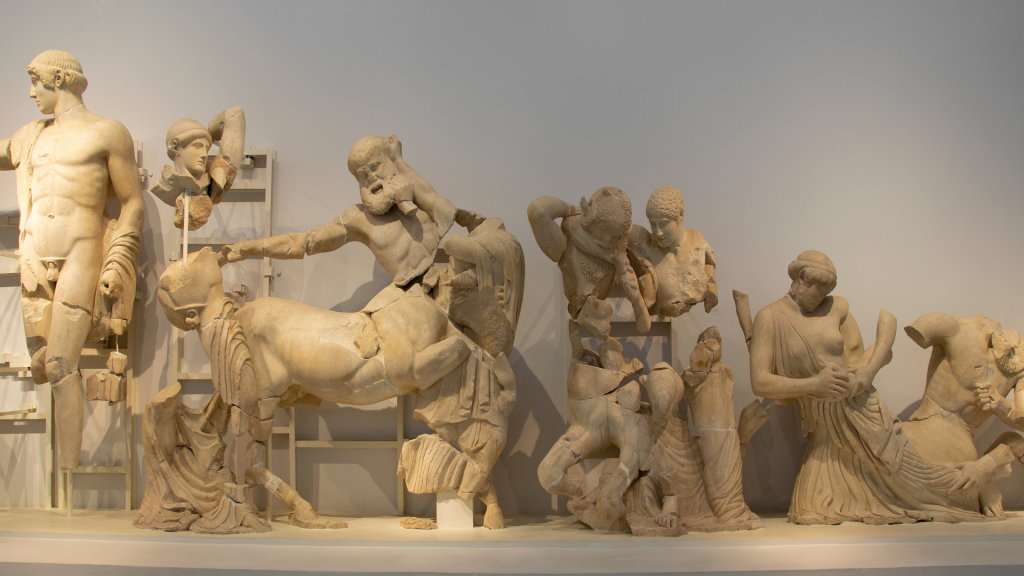The ancient Greeks had a great appreciation for beauty, and this appreciation is evident in the artwork they left behind. From the sculptures of gods and goddesses to the pottery used in everyday life, ancient Greek art is still admired today. In this blog post, we will take a journey through the world of Ancient Greek Art as we explore its beauty, influence, and legacy. Get ready to marvel at the skill of these talented artists and uncover just how much their artwork has shaped our world!
Introduction to Ancient Greek Art
Greek art is often divided into four periods: the Archaic, the Classical, the Hellenistic, and the Roman. The Archaic period is characterized by a more naturalistic style, as opposed to the highly stylized approach of the later periods. The Classical period saw a return to a more idealized style, while the Hellenistic period is marked by a more expressive and emotionally charged approach. Lastly, Roman art represents a synthesis of all previous Greek styles. Ancient Greek art has had a profound impact on subsequent cultures. Many of the most iconic images in Western art can be traced back to Greek originals, including scenes from the Bible and classical mythology. In addition, the principles of beauty and proportion laid out by Greek artists have been hugely influential in both Western and Eastern art traditions.
Overview of Ancient Greek Sculpture
Ancient Greek sculpture is characterized by its highly naturalistic style and its depiction of movement and emotion. Many of the most famous sculptures from Ancient Greece depict scenes from mythology, such as the birth of Athena or the battle of Zeus and Typhon.
The art form flourished during the Archaic and Classical periods, before declining in popularity during the Hellenistic period. Despite this decline, Ancient Greek sculpture continued to exert a significant influence on subsequent artists, both in terms of its style and its subject matter. In particular, the Roman period saw a resurgence in interest in Greek sculpture, with many Roman artists adopting elements of the Greek style in their own work.
Influence of Ancient Greek Architecture on Western Culture
The evolution of Western architecture is indebted to the Greeks. Ancient Greek architects created three classic orders which were adhered to in architectural theory and practice until the mid-19th century. Even today, these orders form an essential part of our architectural vocabulary. The Doric order is characterized by its simple and sturdy design, while the Ionic order features more elaborate decorations. The Corinthian order, which is the most ornate of the three, was named for the city of Corinth and is often associated with grandeur and sophistication. The Parthenon in Athens is one of the most iconic examples of Greek architecture and continues to be an inspiration for architects around the world.
Built-in the 5th century BC, this temple is a prime example of the Doric order. Its columns are fluted and have no base, as they were thought to be inspired by tree trunks. The entablature (the horizontal element between the columns) is also unadorned, in keeping with the Doric style. The Erechtheion on Athens’ Acropolis is another well-known temple that showcases different orders within its design. This so-called œporch of Maidens’ features six slender Caryatids sculpted female figures’ supporting its ionic capital columns.
The popularity of Pottery in Ancient Greek Art
In ancient Greece, pottery was not only a highly utilitarian object but also a work of art. The popularity of pottery in ancient Greece can be seen in the many different styles and types of pots that were produced. Some of the most popular types of Greek pottery included black-figure pots, red-figure pots, and amphorae. Greek potters experimented with different techniques to create unique effects on their pots. Black-figure pottery was created by painting the design on the pot with a slip made from iron oxide and manganese dioxide.
The colors would then be oxidized when the pot was fired, resulting in a black-figure design. Red-figure pottery was created by painting the design on the pot with a slip made from copper oxide. They would then be reduced when the pot was fired, resulting in a red-figure design. Amphorae were large vessels that were used to transport liquids such as wine or oil. They were often decorated with scenes from mythology or daily life.
The popularity of Greek pottery can be seen in its influence on other cultures. For example, Etruscan vessels were often modeled after Greek pots. Roman artists also borrowed heavily from Greek pottery, especially in the area of black-figure painting.
Major Themes in Ancient Greek Paintings and Drawings
There are several major themes that can be found in ancient Greek paintings and drawings. One of the most prominent is the theme of humans and nature. This is often depicted in scenes of everyday life, such as people going about their daily activities or working in the fields. Other common themes include gods and goddesses, mythology, and war.
One of the things that make ancient Greek art so special is its realism. The artists were able to capture the essence of their subjects in a way that was both lifelike and beautiful. This is one of the reasons why Greek art has had such a lasting influence on subsequent cultures.
Contributions to Modern Art Influenced by the Ancients
The legacy of ancient Greek art is evident in the works of many modern artists. From the clean lines of minimalist painting to the bold colors and geometry of abstract expressionism, there are countless ways that the art of Greece has inspired and influenced modern artists. Some of the most notable examples include Pablo Picasso’s “Les Demoiselles d’Avignon”, which was heavily influenced by Greek sculpture, as well as Jackson Pollock’s “Number 1”, which echoes the patterns and shapes found in Greek vase paintings. Even today, many artists continue to be inspired by the beauty and simplicity of ancient Greek art, using it as a foundation for their own unique visions.
Ancient Greek art is truly a marvel and has had an undeniable influence on the world of art throughout history. It offers unique insight into the culture, beliefs, and values of the ancient Greeks, providing us with a window into their lives. From its use of color and symbolism to its intricate sculptures and frescoes, Ancient Greek art has remained captivating for centuries. We hope that this journey through Ancient Greek Art will inspire your own appreciation for this incredible artistic tradition.

